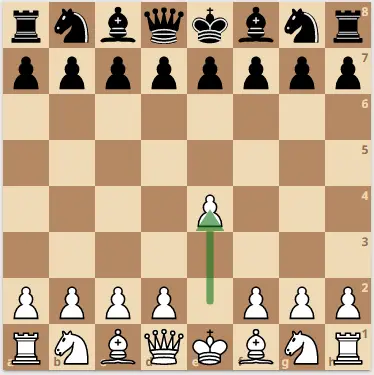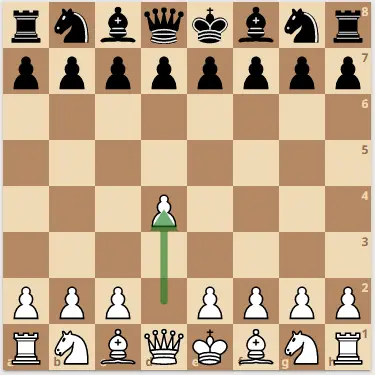Chess pawns may seem like small and insignificant pieces on the board, but they play a crucial role in the game’s strategy and outcome. To fully understand the game of chess, it’s essential to know the specific names given to each pawn on the board.
From the a-pawn to the h-pawn, each pawn has a unique identifier that can help players communicate and analyze moves. In this article, we will explore the origins and meanings behind each chess pawn’s name, providing a comprehensive guide to this critical aspect of chess terminology.
Chess Pawn Names
In chess, the pawns are not individually named. Instead, they are referred to by their positions on the board using the file (column) and rank (row) notation. The pawns are represented by the letters “a” through “h” for the files and numbers “1” through “8” for the ranks.
For example, if we consider the white pawns, they are positioned in the second rank (rank 2) on the board and are named accordingly as a2, b2, c2, d2, e2, f2, g2, and h2.
Similarly, the black pawns are placed in the seventh rank (rank 7) and are denoted as a7, b7, c7, d7, e7, f7, g7, and h7.
It’s worth mentioning that the pawns can be promoted to other chess pieces (such as a queen, rook, bishop, or knight) if they successfully reach the opposite end of the board.
Naming Pawns By Just Their File Name

Pawns can also be named by just the file they reside on. The file represents the columns on the chessboard, labeled from “a” to “h” from left to right.
For example, if there is a pawn on the e-file, it would be referred to as the “e-pawn.” Similarly, a pawn on the b-file would be called the “b-pawn,” and so on.
In general, when discussing pawns in chess, it is more common to use the file name as a shorthand identifier rather than specifying the full unique identifier (file and rank). The file name provides a convenient and concise way to refer to a particular pawn.
For example, if a chess instructor or commentator is analyzing a game and wants to discuss a specific pawn, they would likely refer to it by its file name. It is easier and quicker to say “the e-pawn” rather than “the pawn on the e-file or the e7 pawn.”
That being said, in certain situations where it is necessary to distinguish between pawns on the same file (e.g., when discussing tactics or pawn structures), using the full unique identifier (file and rank) may be more appropriate to avoid any confusion.
In the following example, both pawns sit on the same file. Therefore, you should use both the number and letter to uniquely identify them (b2 and b3)

Naming Pawns By Their Structures
- “Backward Pawn”: This term describes a pawn that is behind its neighboring pawns on adjacent files and has no friendly pawns to support its advance.
- “Doubled Pawns”: When two pawns of the same color are on the same file, they are called “doubled pawns.”
- “Chain Pawns”: If there is a sequence of pawns on adjacent files, they can be referred to as a “pawn chain.” This term is often used to describe a strong defensive or offensive formation.
- “Pawn Majority”: When one side has more pawns on a specific flank of the board (e.g., the queenside or kingside), it is referred to as having a “pawn majority.”
- “Central Pawns”: Pawns occupying the central squares of the chessboard (e.g., d4, e4, d5, e5) are sometimes collectively referred to as the “central pawns.”
- “Passed Pawn”: When a pawn has no opposing pawns to prevent its advancement to promotion, it is called a “passed pawn.” Again, this is not a name for a specific pawn but a descriptive term for a pawn’s condition.
- “Passed Candidate”: This term is used to describe a pawn that has the potential to become a passed pawn after advancing.
- Isolated Pawn”: This term is used to describe a pawn that has no friendly pawns on adjacent files. It is not a specific pawn’s name but rather a description of a specific pawn structure.
- “Hanging Pawn”: This term refers to a pawn that is not defended by another pawn and can be vulnerable to capture or attack.
For more information on pawn structure see article: Weak pawns in chess
Other Ways To Name Pawns
The terms “king pawn,” “queen pawn,” “rook pawn,” “bishop pawn,” and “knight pawn” can be used to name pawns, but is not the best and common way to idenitify pawns.
However, if we interpret these terms in a general sense, we can understand them as follows:
- King Pawn: This term could refer to a pawn that is located in front of the king, typically on either the e-file (e2 for White, e7 for Black). These pawns are often crucial for protecting the king and can play a significant role in opening strategies.
- Queen Pawn: Similarly, the term “queen pawn” might refer to a pawn that is located in front of the queen, usually on the d-file (d2 for White, d7 for Black). Pawns on this file are often involved in various opening systems, such as the Queen’s Gambit.
- Rook Pawn: The term “rook pawn” generally refers to any pawn that is located on one of the corner files (a-file or h-file). Rook pawns can have particular strategic characteristics due to their position and potential to support the rooks’ activities.
- Bishop Pawn: The term “bishop pawn” refers to a pawn on the bishop file, namely c and f file.
- Knight Pawn: Similar to the bishop pawn, the term “knight pawn” refers to a pawn on the knight file, namely b and g files.
King Pawn & Queen Pawn Opening
The King’s Pawn Opening and Queen’s Pawn Opening are two common opening moves in chess that refer to the initial pawn moves made by White. These openings are named based on the movement of the pawn in front of the king or queen.
1. King’s Pawn Opening

The King’s Pawn Opening refers to any opening move by White that starts with the pawn in front of the king (e2) moving forward two squares to e4.
This is often denoted as 1.e4. The King’s Pawn Opening is known for its central control and is the most popular opening move in chess.
Examples of well-known variations that start with the King’s Pawn Opening include:
-
- The Open Game, which includes openings like the Ruy Lopez, Italian Game, and Scotch Game.
- The Double King’s Pawn Opening, where Black also pushes their pawn forward two squares (e5) in response.
2. Queen’s Pawn Opening

The Queen’s Pawn Opening refers to any opening move by White that starts with the pawn in front of the queen (d2) moving forward two squares to d4.
This is often denoted as 1.d4. The Queen’s Pawn Opening is characterized by solid pawn structures and strategic maneuvering.
Examples of well-known variations that start with the Queen’s Pawn Opening include:
-
- The Queen’s Gambit, which arises after 1.d4 d5 2.c4.
- The King’s Indian Defense, where Black responds to 1.d4 with setups involving …Nf6 and …g6.
Both the King’s Pawn Opening and Queen’s Pawn Opening are popular and have been extensively studied and analyzed throughout chess history. They provide different positional and strategic opportunities, leading to a wide range of opening variations and systems.
Conclusion
Understanding the file and rank notation used to identify pawns is fundamental to chess communication and analysis. While pawns lack individual names, their positions on the board hold strategic significance, dictating gameplay and shaping pawn structures.
By grasping the concepts of pawn promotion, pawn breaks, and their roles within formations like isolated pawns or pawn majorities, players can unlock the complexities of chess strategy.
Ultimately, a solid understanding of pawn positions and their implications enhances players’ ability to navigate the chessboard with precision and foresight, ultimately leading to mastery of the game.


